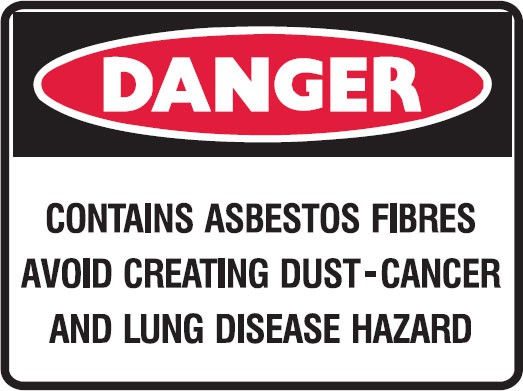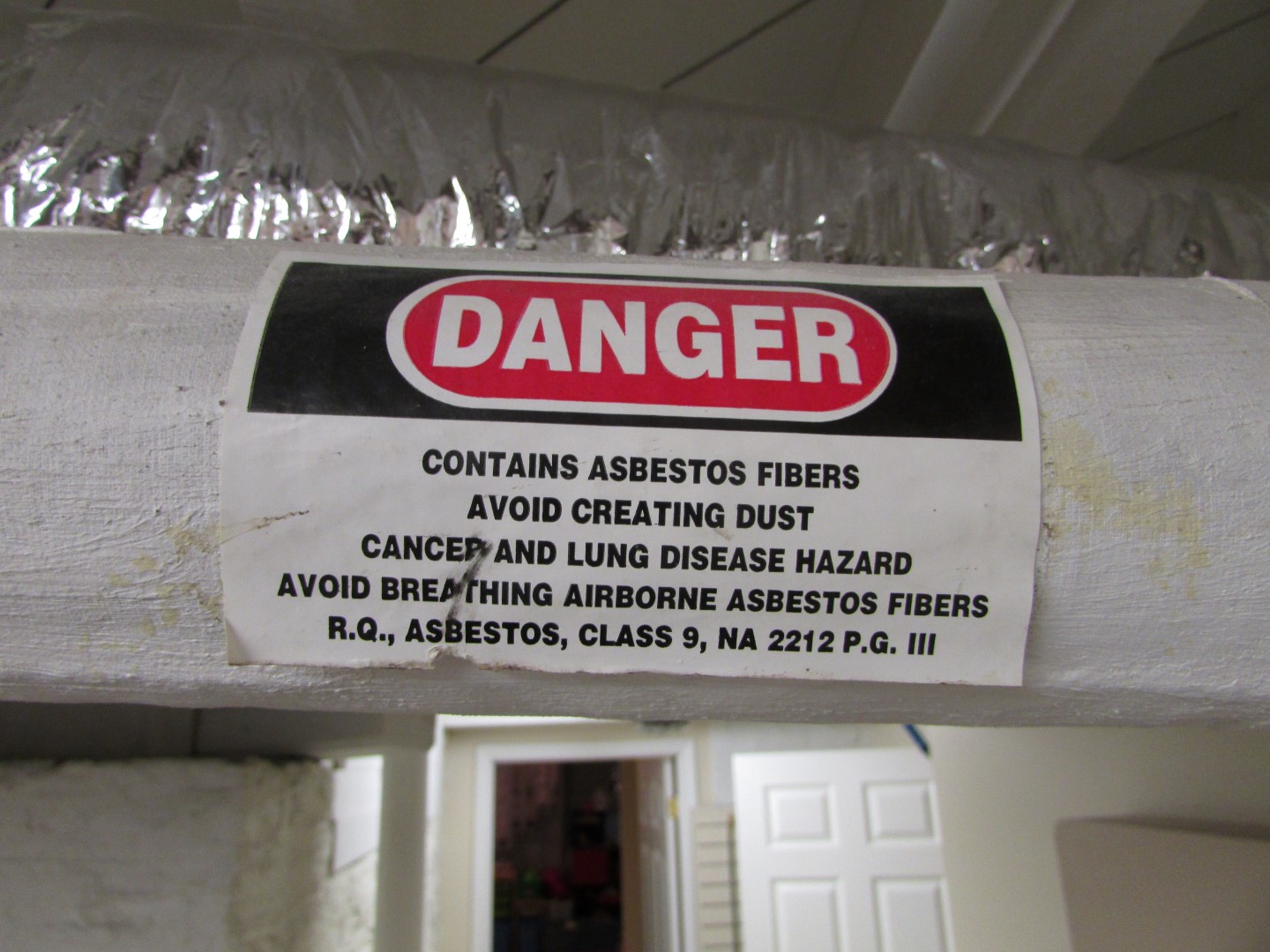Support Page Content
Asbestos
Asbestos is a generic term for a group of minerals known for their strength, flame and heat resistance, and seemingly indestructible qualities.
Once considered a "miracle mineral," asbestos was used for many years in building construction. It can be found in many forms and places. Asbestos was used in boiler and pipe insulation, plasters, floor tile, electrical insulation, and as a fireproofing material on structural members in buildings. It has also been sprayed on ceilings and walls as acoustic insulation.
Because of its indestructible qualities, asbestos is harmful to the human body. The body cannot digest, break down, or change asbestos; it can only attempt to encapsulate it with scar tissue.
Several types of asbestos were banned by the EPA in the mid-70's due to concern over the health effects (especially cancer) associated with exposure to such materials. It is important to remember that asbestos generally has been found to be hazardous to humans only when it is inhaled into the lungs.
Asbestos occurs naturally as a fiber; individual fibers are so small they are invisible to the naked eye. Most asbestos is not hazardous in its original, undisturbed state; only when it is disturbed does it release asbestos fibers.
Symptoms of asbestos-related diseases do not occur soon after exposure. Those who are sick today because of asbestos may have been exposed 20 to 40 years ago. Controlling exposures now will prevent disease and suffering decades later.

Asbestos Resources
Where is Asbestos Found?
Asbestos may be found in many different products and many different places. Examples of products that might contain asbestos are:
- Sprayed on fire proofing and insulation in buildings
- Insulation for pipes and boilers
- Wall and ceiling insulation
- Ceiling tiles
- Floor tiles
- Putties, caulks, and cements (such as in chemical carrying cement pipes)
- Roofing shingles
- Siding shingles on old residential buildings
- Wall and ceiling texture in older buildings and homes
- Joint compound in older buildings and homes
- Brake linings and clutch pads
- Electrical fixtures and wiring
Buildings that have asbestos-containing materials in them will have notices posted near the main entrances, frequently near the fire alarm panel.
Pipe and boiler insulation that contains asbestos will be labeled with identifying stickers and placards.
Asbestos-containing ceiling tiles will not be labeled or marked. These tiles cannot be differentiated from other tile by visual means - they must be analyzed by a laboratory test.
When is Asbestos Dangerous?
The most common way for asbestos fibers to enter the body is through breathing.
In fact, asbestos containing material is not generally considered to be harmful unless it is releasing dust or fibers into the air where they can be inhaled or ingested. Many of the fibers will become trapped in the mucous membranes of the nose and throat where they can then be removed, but some may pass deep into the lungs, or, if swallowed, into the digestive tract. Once they are trapped in the body, the fibers can cause health problems.
Asbestos is most hazardous when it is friable. The term "friable" means that the asbestos is easily crumbled by hand, releasing fibers into the air. Sprayed on asbestos insulation is highly friable. Asbestos floor tile is not.
Asbestos-containing ceiling tiles, floor tiles, undamaged laboratory cabinet tops, shingles, fire doors, siding shingles, etc. will not release asbestos fibers unless they are disturbed or damaged in some way. If an asbestos ceiling tile is drilled or broken, for example, it may release fibers into the air. If it is left alone and not disturbed, it will not.
Asbestos pipe and boiler insulation does not present a hazard unless the protective canvas covering is cut or damaged in such a way that the asbestos underneath is actually exposed to the air.
Damage and deterioration will increase the friability of asbestos-containing materials. Water damage, continual vibration, aging, and physical impact such as drilling, grinding, buffing, cutting, sawing, or striking can break the materials down making fiber release more likely.

Avoiding Asbestos Exposure
In order to avoid being exposed to asbestos, you must be aware of the locations it is likely to be found. If you do not know whether something is asbestos or not, assume that it is until it is verified otherwise. Remember that you cannot tell if floor or ceiling tiles contain asbestos just by looking at them.
The Environmental Health and Safety Department has contracted with an asbestos certified testing laboratory and selected employees at CSUS have been trained to take samples from materials in order to determine whether or not they contain asbestos. If you need to have materials analyzed or tested for asbestos, please contact EH&S at xt.82020. Never try to take a sample yourself unless you are trained to do so.
If you have reason to suspect that something is asbestos, either because it is labeled as such, or because it something that is likely to contain asbestos (9" floor tile, for example) DO NOT DISTURB IT.
Never:
- Drill
- Hammer
- Cut
- Saw
- Break
- Damage
- Move
- Disturb any asbestos-containing materials or suspected materials.
EH&S, in conjunction with Facilities Management has surveyed many campus buildings for the presence of asbestos. If you need to do work that might involve asbestos (lifting ceiling tiles, repairing insulated pipelines, etc.), check with EH&S to find out what can be done safely.
For example, before moving any ceiling tiles to perform maintenance work, it will be necessary to ensure they do not contain asbestos. If they do contain asbestos, they will need to be removed by licensed asbestos abatement workers before the work may be performed.
Asbestos-Related Disease
Lung Cancer
Lung cancer causes the largest number of deaths related to asbestos exposure. The incidence of lung cancer in people who are directly involved in the mining, milling, manufacturing and use of asbestos and its products is much higher than in the general population. The most common symptoms of lung cancer are coughing and a change in breathing. Other symptoms include shortness of breath, persistent chest pains, hoarseness, and anemia.
People who have been exposed to asbestos and are also exposed to some other carcinogen -- such as cigarette smoke -- have a significantly greater risk of developing lung cancer than people who have only been exposed to asbestos. One study found that asbestos workers who smoke are about 90 times more likely to develop lung cancer than people who neither smoke nor have been exposed to asbestos.
Mesothelioma
Mesothelioma is a rare form of cancer which most often occurs in the thin membrane lining of the lungs, chest, abdomen, and (rarely) heart. About 200 cases are diagnosed each year in the United States. Virtually all cases of mesothelioma are linked with asbestos exposure. Approximately 2 percent of all miners and textile workers who work with asbestos, and 10 percent of all workers who were involved in the manufacture of asbestos-containing gas masks, contract mesothelioma.
People who work in asbestos mines, asbestos mills and factories, and shipyards that use asbestos, as well as people who manufacture and install asbestos insulation, have an increased risk of mesothelioma. So do people who live with asbestos workers, near asbestos mining areas, near asbestos product factories or near shipyards where use of asbestos has produced large quantities of airborne asbestos fibers.
Other Cancers
Evidence suggests that cancers in the esophagus, larynx, oral cavity, stomach, colon and kidney may be caused by ingesting asbestos. For more information on asbestos-related cancers, contact your local chapter of the American Cancer Society.
Health Effects
Because it is so hard to destroy asbestos fibers, the body cannot break them down or remove them once they are lodged in lung or body tissues. They remain in place where they can cause disease.
There are three primary diseases associated with asbestos exposure:
- Asbestosis
- Lung Cancer
- Mesothelioma
Asbestosis
Asbestosis is a serious, chronic, non-cancerous respiratory disease. Inhaled asbestos fibers aggravate lung tissues, which causes them to scar. Symptoms of asbestosis include shortness of breath and a dry crackling sound in the lungs while inhaling. In its advanced stages, the disease may cause cardiac failure.
There is no effective treatment for asbestosis; the disease is usually disabling or fatal. The risk of asbestosis is minimal for those who do not work with asbestos; the disease is rarely caused by neighborhood or family exposure. Those who renovate or demolish buildings that contain asbestos may be at significant risk, depending on the nature of the exposure and precautions taken.
Determining Factors
Three things seem to determine your likelihood of developing one of these asbestos-related diseases:
- The amount and duration of exposure: the more you are exposed to asbestos and the more fibers that enter your body, the more likely you are to develop asbestos related problems. While there is no "safe level" of asbestos exposure, people who are exposed more frequently over a long period of time are more at risk.
- Whether or not you smoke: if you smoke and you have been exposed to asbestos, you are far more likely to develop lung cancer than someone who does not smoke and who has not been exposed to asbestos. If you work with asbestos or have been exposed to it, the first thing you should do to reduce your chances of developing cancer is to stop smoking. Organizations that may offer programs, support, or information to help people stop smoking are:
- CSUS Student Health Center
- National Cancer Institute (1-800-4-CANCER)
- American Heart Association (1-800-242-8721)
- American Lung Association
- Age: Cases of mesothelioma have occurred in the children of asbestos workers whose only exposures were from the dust brought home on the clothing of family members who worked with asbestos. The younger people are when they inhale asbestos, the more likely they are to develop mesothelioma. This is why enormous efforts are being made to prevent school children from being exposed. Because each exposure to asbestos increases the body burden of asbestos fibers, it is very important to reduce and minimize your exposure.
Prevention
Housekeeping
Housekeepers and custodians should never sand or dry buff asbestos containing floor tiles, and only wet stripping methods may be used during stripping operations. Low abrasion pads should be used at speeds below 300 rpm.
Broken and fallen ceiling tiles should be left in place until identified. Only after they have been identified as safe may they be removed. Asbestos tiles will be removed by trained asbestos abatement workers.
Broken and damaged asbestos floor tiles must also be removed by trained asbestos abatement workers. Report any suspect broken tiles to EHS at xt. 82020.
Spills
It is important to report any damaged asbestos-containing materials to EH&S at xt. 82020 immediately. If, for example, you discover some sprayed-on asbestos insulation has been knocked off of a ceiling or wall, this would be considered a "spill." As such it would need to be cleaned up immediately by trained asbestos abatement workers. Do not attempt to clean up spills yourself! Disturb the material as little as possible. Also report any damaged pipe insulation, ceiling tile, 9" floor tile, fallen clumps of sprayed-on insulation, etc. Take measures to prevent others from disturbing the spill until the Trained Asbestos Abatement crew arrives.
By knowing where asbestos is likely to be located and then taking measures not to disturb it, you will protect yourself and others from exposure to this hazardous substance.